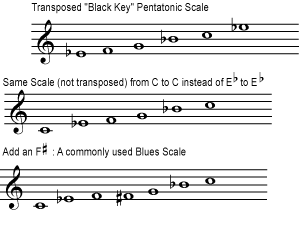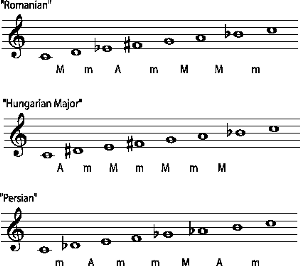| << Chapter < Page | Chapter >> Page > |

The point here is that music based on the pentatonic scale in [link] will sound very different from music based on the pentatonic scale in [link] , because the relationships between the notes are different, much as music in a minor key is noticeably different from music in a major key. So there are quite a few different possible pentatonic scales that will produce a recognizably "unique sound", and many of these possible five-note scales have been named and used in various music traditions around the world.
To get a feeling for the concepts in this section, try composing some short pieces using the pentatonic scales given in [link] and in [link] . You may use more than one octave of each scale, but use only one scale for each piece. As you are composing, listen for how the constraints of using only those five notes, with those pitch relationships, affect your music. See if you can play your [link] composition in a different key, for example, using the scale in [link] .
If you can, have your teacher listen to your compositions.
Any scale will list a certain number of notes within an octave. For major and minor scales, there are seven notes; for pentatonic, five; for a chromatic scale, twelve. Although some divisions are more common than others, any division can be imagined, and many are used in different musical traditions around the world. For example, the classical music of India recognizes twenty-two different possible pitches within an octave; each raga uses five, six, or seven of these possible pitches. (Please see Indian Classical Music: Tuning and Ragas for more on this.) And there are some traditions in Africa that use six or eight notes within an octave. Listen to one possible eight-tone, or octatonic scale .

Many Non-Western traditions, besides using different scales, also use different tuning systems ; the intervals in the scales may involve quarter tones (a half of a half step), for example, or other intervals we don't use. Even trying to write them in common notation can be a bit misleading.
Microtones are intervals smaller than a half step. Besides being necessary to describe the scales and tuning systems of many Non-Western traditions, they have also been used in modern Western classical music, and are also used in African-American traditions such as jazz and blues. As of this writing, the Huygens-Fokker Foundation was a good place to start looking for information on microtonal music.
Blues scales are closely related to pentatonic scales. (Some versions are pentatonic.) Rearrange the pentatonic scale in [link] above so that it begins on the C, and add an F sharp in between the F and G, and you have a commonly used version of the blues scale. Listen to this blues scale .

Many music traditions do not use scales. The most familiar of these to the Western listener are medieval chant and the classical music of India. In these and other modal traditions, the rules for constructing a piece of music are quite different than the rules for music that is based on a scale. Please see Modes and Ragas for more information.
There are many, many other possible scales that are not part of the major-minor system. Some, like pentatonic and octatonic scales, have fewer or more notes per octave, but many have seven tones, just as a major scale does. A scale may be chosen or constructed by a composer for certain intriguing characteristics, for the types of melodies or harmonies that the scale enables, or just for the interesting or pleasant sound of music created using the scale.
For example, one class of scales that intrigues some composers is symmetrical scales . The chromatic scale and whole tone scales fall into this category, but other symmetrical scales can also be constructed. A diminished scale, for example, not only has the "symmetrical" quality; it is also a very useful scale if, for example, you are improvising a jazz solo over diminished chords .

Some scales are loosely based on the music of other cultures, and are used when the composer wants to evoke the music of another place or time. These scales are often borrowed from Non-western traditions, but are then used in ways typical of Western music. Since they usually ignore the tuning, melodic forms, and other aesthetic principles of the traditions that they are borrowed from, such uses of "exotic" scales should not be considered accurate representations of those traditions. There are examples in world music , however, in which the Non-western scale or mode is used in an authentic way. Although there is general agreement about the names of some commonly used "exotic" scales, they are not at all standardized. Often the name of a scale simply reflects what it sounds like to the person using it, and the same name may be applied to different scales, or different names to the same scale.

You may want to experiment with some of the many scales possible. Listen to one version each of: "diminished" scale , "enigmatic" scale , "Romanian" Scale , "Persian" scale and "Hungarian Major" Scale . For even more possibilities, try a web search for "exotic scales"; or try inventing your own scales and using them in compositions and improvisations.


Notification Switch
Would you like to follow the 'Special subjects in music theory' conversation and receive update notifications?